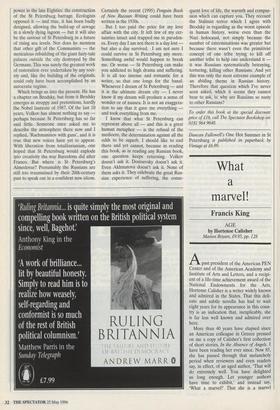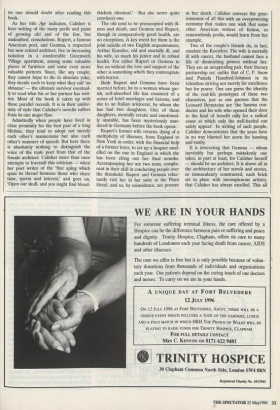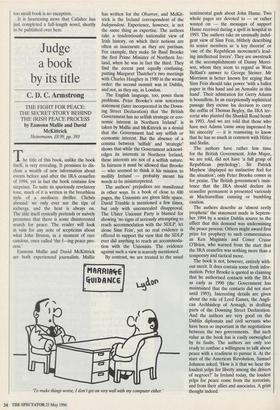What a marvel!
Francis King
AGE Apast president of the American PEN Center and of the American Academy and Institute of Arts and Letters, and a recipi- ent of a life-time achievement award of the National Endowments for the Arts, Hortense Calisher is a writer widely known and admired in the States. That this deli- cate and subtle novella has had to wait eight years for its appearance in this coun- try is an indication that, inexplicably, she is far less well known and admired over here.
More than 40 years have elapsed since an American colleague in Greece pressed on me a copy of Calisher's first collection of short stories, In the Absence of Angels. I have been reading her ever since. Now 85, she has passed through that melancholy period when reviewers and even readers say, in effect, of an aged author, 'That will do extremely well. You have delighted us long enough. Let younger authors have time to exhibit,' and instead say, 'What a marvel!' That she is a marvel no one should doubt after reading this book.
As her title Age indicates, Calisher is here writing of the many perils and pains of growing old and of the few, but undoubted, consolations. Rupert, a famous American poet, and Gemma, a respected but now retired architect, live in increasing isolation in a comfortable Greenwich Village apartment, among some valuable pieces of furniture and some even more valuable pictures. Since, like any couple, they cannot hope to die in absolute yoke, they decide each to keep what they call 'an almanac' — the ultimate survivor eventual- ly to read what his or her partner has writ- ten. Most of the book is taken up with these parallel records. It is in their unifor- mity of style that Calisher's novella suffers from its one major flaw.
Admittedly when people have lived in close proximity for the best part of a long lifetime, they tend to adopt not merely each other's mannerisms but also each other's manners of speech. But here there is absolutely nothing to distinguish the voice of the male poet from that of the female architect. Calisher more than once attempts to forestall this criticism — when her poet writes of the 'fine aping which spins its thread between those who share time, sperm and interest,' and goes on, 'Open our skull, and you might find blood- thickets identical.' But she never quite convinces one.
The old tend to be preoccupied with ill- ness and death, and Gemma and Rupert, though in comparatively good health, are no exceptions. A key event for them is the joint suicide of two English acquaintances, Arthur Koestler, old and mortally ill, and his wife, so much his junior and in robust health. For either Rupert or Gemma to live on without the love and support of the other is something which they contemplate with horror.
Both Rupert and Gemma have been married before, he to a woman whose gar- ish, self-absorbed life has consisted of a series of brief marriages and liaisons, and she to an Italian aristocrat, by whom she has had two daughters. One of these daughters, mentally erratic and emotional- ly unstable, has been mysteriously mur- dered in Germany before the book opens. Rupert's former wife returns, dying of a multiplicity of illnesses, from England to New York in order, with the financial help of a former lover, to set up a hospice mod- elled on the one in England in which she has been eking out her final months. Accompanying her are two nuns, compla- cent in their skill in conducting people over the threshold. Rupert and Gemma reluc- tantly visit her in her suite at the Plaza Hotel, and so, by coincidence, are present at her death. Calisher conveys the grue- someness of all this with an overpowering economy that makes one wish that some other American writers of fiction, so remorselessly prolix, would learn from her example.
Two of the couple's friends do, in fact, emulate the Koestlers. The wife is mortally ill with cancer, the husband cannot face a life of diminishing powers without her. They are an unappealing pair, their literary partnership not unlike that of C. P. Snow and Pamela Hansford-Johnson in its relentless striving not merely for excellence but for power. One can guess the identity of the real-life prototypes of these two characters, just as one guesses that the Leonard Bernsteins are 'the famous con- ductor and his wife who opened their door to the kind of benefit rally for a radical cause at which only the well-heeled can safely appear'. In writing of such people, Calisher demonstrates that the years have in no way blunted her scorn for humbug and vanity.
It is interesting that Gemma — whom inevitably but perhaps mistakenly one takes, in part at least, for Calisher herself — should be an architect. It is above all in the architecture of her novels and stories, so immaculately constructed, each brick set in place with inconspicuous artistry, that Calisher has always excelled. This all too small book is no exception.
It is heartening news that Calisher has just completed a full-length novel, shortly to be published over here.




























































 Previous page
Previous page